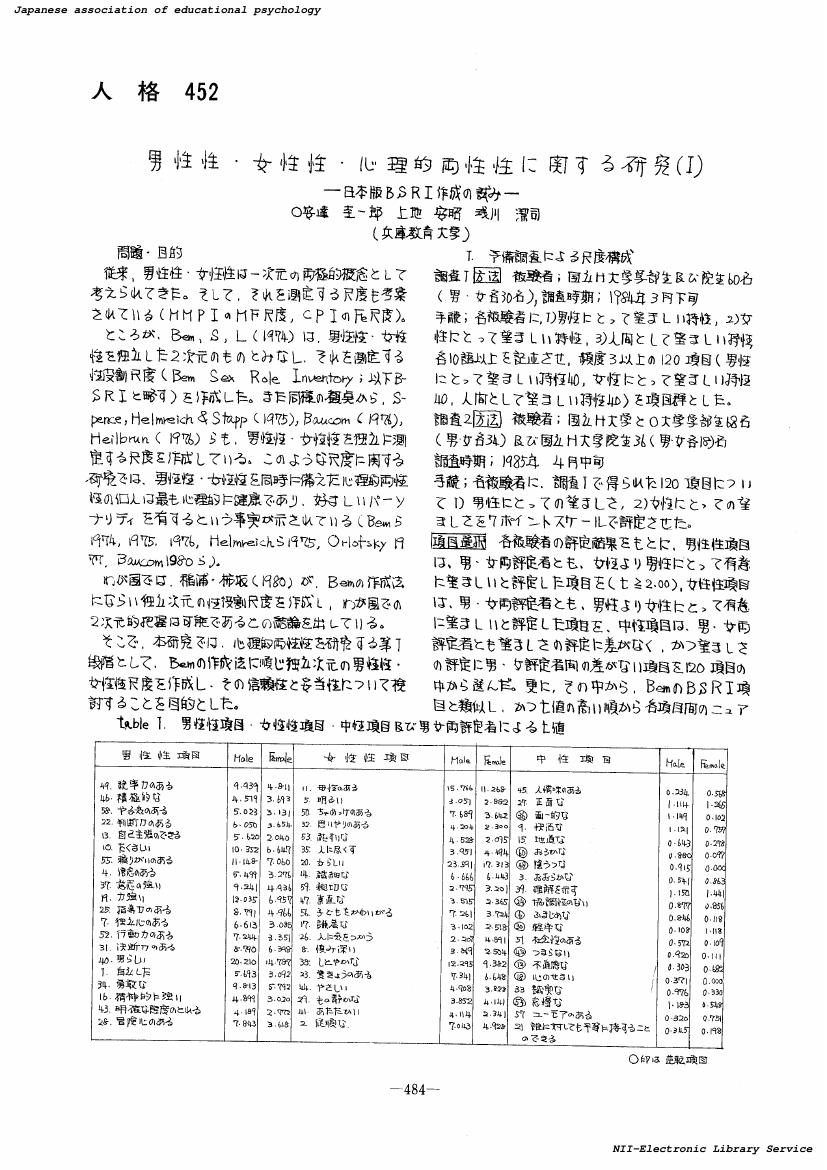- 著者
- 安達 圭一郎
- 出版者
- 九州ルーテル学院大学
- 雑誌
- 応用障害心理学研究
- 巻号頁・発行日
- no.11, pp.91-100, 2012-03
本研究では, 性同一性障害(Female to Male)と自称する青年(A)とのメールを通じた初期のインタビュー場面で生じたインタビュアーの逆転移とインタビュイーイメージの変遷について検討することを目的とした。インタビュアーは性同一性障害と自認する若者とは初めての関わりであったため, インタビュー開始前から多くの文献を参照し, 一般的な性同一性障害当事者達が置かれている境遇とそこにおける彼らの生きにくさに注目して関わった。こうした間接的な逆転移は, その後のA理解に大きく影響し, インタビュアー側の「焦り」「無力感」「怒り」といった逆転移感情と結びついたAイメージを生成した。さらに, そのことは, インタビュー構造の崩壊とインタビュアーのエナクトメントをも引き起こすことになった。しかし, Aのメールを転機に, インタビュアーは自己の逆転移感情に気づき, 全体的対象としてのA理解が可能となった。こうした経緯を, やまだ(2007)の対話的モデル構成法を援用して質的に検討した。This study was proposed to clarify how interviewer's countertransference and interviewee image changed through exchanging E-mail with an adolescent (A) recognizing him/her self "Gender Identity Disorder" (GID: female to male) in an early interview session. Because it was the interviewer's first time to have contact with such an individual, prior to the interview interviewer read many articles concerning GID. Interviewer imagined A as a so-called general GID patient, feeling his/her life should be hard in needy circumstances. Afterwards, interviewer's indirect countertransference influenced understanding of A and formed a partial image of A connected with interviewer's feelings (i.e., impatience, helplessness, and anger). Moreover, this situation caused partial destruction of interview setting and facilitated interviewer's enactment. However, taking advantage of E-mail from A, interviewer was conscious of the countertransference feelings and could understand A as a whole person. This process was qualitatively studied and discussed in consideration of Methodology of Dialogue Model Construction (Yamada, 2007).
- 著者
- 安達 圭一郎 上野 徳美
- 出版者
- 日本行動医学会編集委員会
- 雑誌
- 行動医学研究 : 日本行動医学会誌 (ISSN:13416790)
- 巻号頁・発行日
- vol.19, no.1, pp.25-31, 2013-03
- 著者
- 安達 圭一郎 上地 安昭 浅川 潔司
- 出版者
- 一般社団法人 日本教育心理学会
- 雑誌
- 日本教育心理学会総会発表論文集 第27回総会発表論文集 (ISSN:21895538)
- 巻号頁・発行日
- pp.484-485, 1985-08-20 (Released:2017-03-30)
1 0 0 0 OA 日本語版チームに対する心理的安全尺度看護師用(Japanese version of Team Psychological Safety for Nurses: JPSN)の作成と信頼性・妥当性の検討
- 著者
- 浅海 菜月 安達 圭一郎 大神 綾夏
- 出版者
- 一般社団法人 日本看護研究学会
- 雑誌
- 日本看護研究学会雑誌 (ISSN:21883599)
- 巻号頁・発行日
- pp.20220126178, (Released:2022-12-23)
- 参考文献数
- 19
目的:心理的安全を用いたモデルを看護師の職務場面に応用するため,看護師の心理的安全認識を測定する「日本語版チームに対する心理的安全尺度看護師用(JPSN)」を作成し,信頼性と妥当性を検討した。方法:Amy Edmondson(1999)のTeam psychological safety scale を開発者の許諾を得て翻訳した。逆翻訳と研究者間のレビューを行い暫定版を作成し,病棟看護師チームに所属する看護師を対象に無記名自記式質問紙を用いてWeb調査を行った。結果:515名を分析した。探索的因子分析にて原版同様の1因子7項目が抽出され,確認的因子分析にて良好な適合度を示した。尺度全体の信頼性係数(.787)と構成概念妥当性の検討より,信頼性と妥当性が示された。結論:JPSNは本邦の看護師に使用できることが確認された。今後,心理的安全認識と看護実践との関連性の探求が期待される。
1 0 0 0 OA 日本語版チームに対する心理的安全尺度看護師用(Japanese version of Team Psychological Safety for Nurses: JPSN)の作成と信頼性・妥当性の検討
- 著者
- 浅海 菜月 安達 圭一郎 大神 綾夏
- 出版者
- 一般社団法人 日本看護研究学会
- 雑誌
- 日本看護研究学会雑誌 (ISSN:21883599)
- 巻号頁・発行日
- vol.45, no.5, pp.5_897-5_903, 2023-01-20 (Released:2023-01-20)
- 参考文献数
- 19
目的:心理的安全を用いたモデルを看護師の職務場面に応用するため,看護師の心理的安全認識を測定する「日本語版チームに対する心理的安全尺度看護師用(JPSN)」を作成し,信頼性と妥当性を検討した。方法:Amy Edmondson(1999)のTeam psychological safety scale を開発者の許諾を得て翻訳した。逆翻訳と研究者間のレビューを行い暫定版を作成し,病棟看護師チームに所属する看護師を対象に無記名自記式質問紙を用いてWeb調査を行った。結果:515名を分析した。探索的因子分析にて原版同様の1因子7項目が抽出され,確認的因子分析にて良好な適合度を示した。尺度全体の信頼性係数(.787)と構成概念妥当性の検討より,信頼性と妥当性が示された。結論:JPSNは本邦の看護師に使用できることが確認された。今後,心理的安全認識と看護実践との関連性の探求が期待される。
- 著者
- 白蓋 真弥 網木 政江 浅海 菜月 桐明 祐弥 生田 奈美可 安達 圭一郎 田中 愛子
- 出版者
- 山口大学医学会
- 雑誌
- 山口医学 (ISSN:05131731)
- 巻号頁・発行日
- vol.70, no.4, pp.165-173, 2021-12-02 (Released:2021-12-24)
- 参考文献数
- 13
【目的】新型コロナウイルス感染拡大の影響により,臨地での看護学実習の機会が減少した2020年度卒業生の看護実践能力を明らかにすること,さらにコロナ禍以前に看護基礎教育を受けた2018年および2019年度卒業生の卒業時看護実践能力との比較を通して,2020年度卒業生の看護実践能力の特徴を明らかにすることを目的とした.【方法】2020年度卒業生77名および既卒生56名に対し,無記名選択式一部記述式の自記式質問紙調査を実施した.【結果】有効回答率は2020年度卒業生74.0%,既卒生35.7%であった.2020年度卒業生の看護実践能力の平均点が高かった項目は「看護の実施にあたり,その人の意思決定を支援することができる.」や「多様な価値観・信条や生活背景を持つ人を尊重する行動をとることができる.」等のヒューマンケアの基本に関する実践能力群に含まれるものであった.また,感染防止対策に関する項目も平均点が高かった.2020年度卒業生および既卒生の平均点を比較したところ,66項目中62項目で2020年度卒業生の平均点が有意に高かった.また,既卒生平均点の順位を基準として,2020年度卒業生平均点の順位を比較し,順位が大幅に下降した項目は,実施する看護の根拠と方法を人々に合わせ説明すること,回復期や慢性的な健康課題に関する看護等であった.一方で順位が大幅に上昇した項目は,家族アセスメントやエンドオブライフケア等であった.【結論】2020年度卒業生は一定の看護実践能力を身につけることができたと自己評価していた.しかし,臨地で実習できていないために,現実的な視点からの評価ができていない可能性があった.
1 0 0 0 OA 物語行為と心理療法
- 著者
- 安達 圭一郎
- 出版者
- 九州ルーテル学院大学
- 雑誌
- 紀要visio : research reports = Visio (ISSN:13432133)
- 巻号頁・発行日
- vol.37, pp.23-28, 2008-07
1 0 0 0 OA 境界性パーソナリティ傾向に対する予測因子としての抑うつと回避
- 著者
- 安達 圭一郎 上野 徳美
- 出版者
- 日本行動医学会
- 雑誌
- 行動医学研究 (ISSN:13416790)
- 巻号頁・発行日
- vol.19, no.1, pp.25-31, 2013 (Released:2014-07-03)
- 参考文献数
- 31
近年、うつ病などの気分障害患者は増加傾向にある。また、こうした気分障害と境界性パーソナリティ障害との併存率の高さを指摘する研究は数多くなされてきた。しかしながら、気分障害と境界性パーソナリティ障害との関連性について、診断学的に因果関係があるのかどうかについては十分なコンセンサスを得ていない。そこで、本研究は、探索的研究として、大学生を対象に、抑うつ傾向と境界例心性との関連性について、回避を媒介変数としたパスモデルを作成し、共分散構造分析で検討した。その結果、抑うつ傾向は回避を媒介として境界例心性に影響をもつということ、さらに、抑うつ傾向は直接的に境界例心性に影響することが確認された。一方、回避を媒介としないものの、境界例心性から抑うつ傾向への逆向きのパスモデルも適合度指標が高かった。以上の結果から、今後は、臨床群を対象にしたモデルの再検討の必要性が示唆された。
